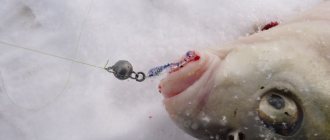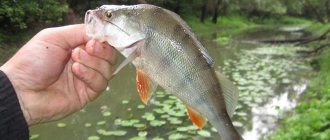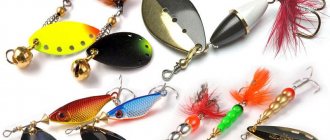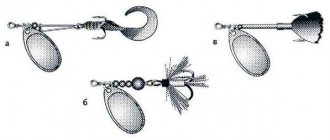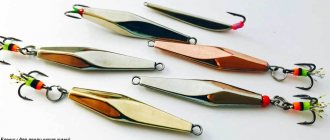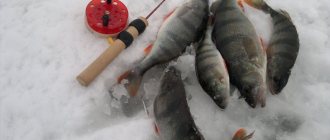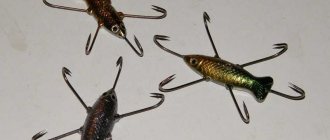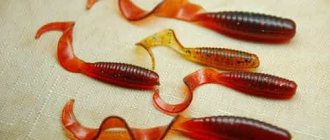Among predator baits, the spinner has a number of unique advantages. The fact is that any predatory fish has excellently developed senses of motion perception. A standard spinner with rigidly attached hooks creates a modest game with both slow and fast retrieves. In reservoirs where there are few fish or where they are cautious, this may not be enough. Popular among spinners, catching perch with a spinner arose when the blade of the spinner was disconnected from the hooks and allowed to rotate freely while moving.
Types of spinners for catching perch
In the classic version, this bait is equipped with one petal. There are three main forms of metal plate:
- Aglia . It has a round petal that tends to open at a large angle and creates strong resistance during wiring. As the speed of movement increases, the spoon is pushed closer to the surface. Aglia is often used when fishing in snags or in places with dense deep vegetation. Deflection of the spoon from the main axis by 50–70 degrees helps prevent small grass from snagging.
- Long . The petal resembles a willow leaf, which is why its resistance in water is insignificant. A spoon at an acute angle (25–35 degrees) often tends to press against the axis of the bait. Fishermen use Long for fishing the bottom or in places with strong currents.
- Comet . The most universal form of turntables. The oval silhouette of the petal allows you to make drawings at different depths. The spinner has average (between Long and Aglia) indicators in terms of width and angle of deviation from the axis.
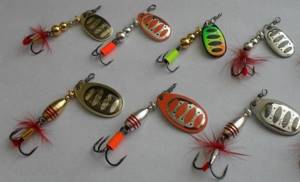
Some manufacturers use tricks to increase the attention of a predator:
- Holes are drilled in the petals. This gives the lure additional swirls.
- Rattle installation. These lures are chosen during active perch feeding.
- Increasing the number of petals - additional vibrations and noise are created in the water.
- Bright plumage is mounted on the tees - this creates an additional irritant for the perch sitting in ambush at the bottom of the reservoir.
Top 10 spinners for perch
We present to your attention the 10 best options for successful fishing with perch spoons.
Mepps Aglia Long
Mepps Aglia Long is a high-tech bait. It has a rounded petal that rotates at an angle of 60 degrees to the axis. There are seven sizes, for example 00, 01 is suitable for an ultra-light rod.
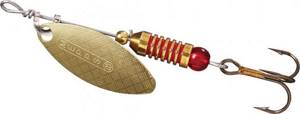
And sizes 2 and 3 are universal for any body of water and river. The Mepps Aglia Long spinner is designed and manufactured in such a way that the petal rotates even at the lowest wiring speeds. The petal itself does not stick and does not stop at different speeds.
Mepps Black Fury
Mepps Black Fury translates to "fuzzy black fury" due to the colored dots on the black backing, it looks like a large insect. Since the petals are of different colors, it is possible to choose a spoon for any fishing spot.
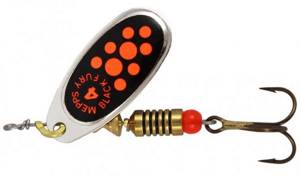
It should be noted that during their development, predatory fish also feed on insects for some period; this period remains in their memory. Maybe this explains why the bait is so popular.
Mepps Comet
Mepps Comet is one of the most famous spinners. It has many directions that are united by one petal shape. Because of this, it works more dynamically and creates powerful vibrations. The predator hears this from great distances.
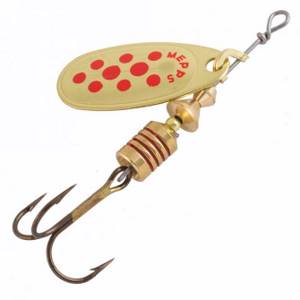
These lures are perfect for pike and perch, including pike perch. The design of the spinners is similar to all spinners: a wire axis, a bracket with a petal, a ribbed body, a triple hook.
Smith Pure
Smith Pure is the most famous oscillating lure for perch from the Japanese company Smith. If you translate it, you get “purebred”. It looks like an oblong teaspoon with a slight bend and a hole at each end.
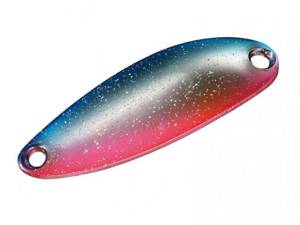
The side inside the bait has a metal color. The convex side is painted in three layers in different colors. Her game is stable and does not falter in different currents.
Smith Niakis
Smith Niakis is a turntable from a Japanese manufacturer. Very stable when wired, especially suitable for slow play. It should be noted that the body of the spinner is a small fish with a noticeable notch on its scales and eyes.
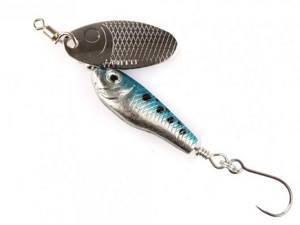
It is placed slightly forward, which prevents the line from twisting. This bait allows you to cast yourself a decent distance and starts up instantly. Has a wide range of colors.
SV-Fishing Koketka
SV-Fishing Koketka is a classic spoon, a universal bait for catching predators, and also one of the top lures for perch. Having good casting data, it starts immediately with the slowest retrieve.
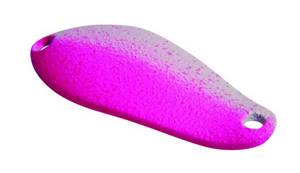
You should alternate between moving and pausing the bait almost until it stops completely. The movements of the tail, especially, quickly attract perch, and the wide colors make it possible to choose a spoon for different fishing conditions.
Blue Fox Super Vibrax
Blue Fox Super Vibrax is a turntable from Finland. Its difference from other turntables is the presence of an internal core with notches. The outer core is a bell.
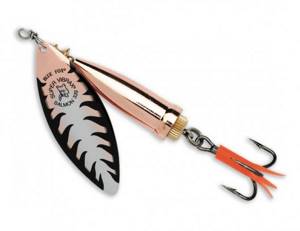
All this creates additional noise during wiring. The petal starts up quickly. All bait has a high-quality coating. It is best to use it during the current, it works great. The perch goes for the bait, perhaps it is attracted by the bell.
{banner_vnutri-kontenta-3}
Daiwa Silver Creek
Daiwa Silver Creek is a turntable from Daiwa. Having a heavy core, the bait flies over a considerable distance. Thanks to this, the wiring is stable in strong currents. The rounded petal, forming powerful vibrations, works even in standing water.
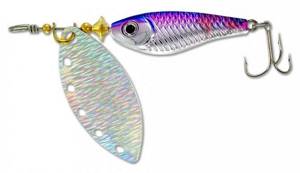
The core is presented in the shape of a fish and is painted naturally - holographic coloring, metallic shine and realistic scales provoke the most insecure perch.
Pontoon21 Ball Concept
Pontoon21 Ball Concept - has a stacked ball core. They are shifted towards the rear of the bait. This has a positive effect on casting distance and accuracy. The balls also make a peculiar noise when moving.
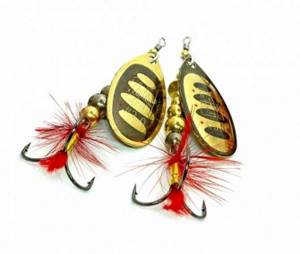
The petal deviates from the axis by 45 degrees. This allows the spinner to move in still water and strong currents. Another highlight of the bait is the small fly.
ABU GARCIA TOBY
ABU GARCIA TOBY is an oscillating spoon made in Sweden. It is suitable for catching all predators, and especially for perch. Works well both during pull-ups and free swimming. Its thickness ranges from 2.5 mm to 05 mm.
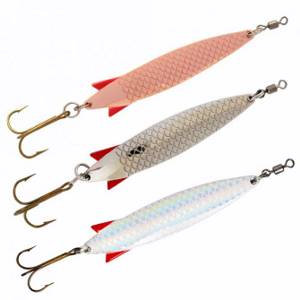
The oblong shape of a perch spinner with a decent weight is just what you need for long-distance casting. After falling, the bait quickly sinks to the bottom, so it is not suitable for surface fishing. When reeling, the spinner creates a yaw from side to side. Similar to bleak.
What to look for when choosing
When preparing to catch perch with spinners, there are several factors to consider:
- Petal size. As a rule, it is indicated on the packaging. For small and medium-sized perch, baits numbered from 0 to 3 are suitable. The thickness of the fishing line is selected after choosing the main bait.
- Lure color. Color mismatch can seriously ruin your holiday on the water. In sunny weather and during daylight hours, as well as in clear water, it is important to use spinners in dark tones and colors (red, green, blue, etc.). Without a pattern, we can choose matte brass lures. At dusk, in cloudy weather or in a muddy pond, on the contrary, it is better to install baits that give glare: silver, golden. In your arsenal, it is also advisable to have spinners with bright contrasting spots or stripes (orange on black, red on white, etc.) - the predator sometimes reacts to them more aggressively.
- Rod strength. Test numbers are indicated on each spinning rod and the weight of the bait must correspond to it. Too light spinners on forms with a fast action will not allow the fisherman to sense the moment of attack in a timely manner. Too heavy lures, on the contrary, bend the rod during retrieving and often lead to predators being cut off.
- Cord thickness. There is no point in tying a thick fishing line on a small spinner, just as there is no point in hanging a cord that is too thin when catching a large predator. The ratio of the sizes of the spinning equipment should be optimal. So for the third number it is enough to set the fishing line from 0.18 to 0.2, depending on the activity of the fish and possible snags on the grass. The braid may have a smaller diameter (for example, 0.1). A non-flexible cord better transfers the perch bite to the rod handle.
- Place where you will fish: type of reservoir, presence of vegetation, water purity, ease of fishing from the shore or from a boat.
- Weight of trophies in fishing areas, reviews from fishermen. When preparing gear, it is advisable to select bait based on the prospects of catching a predator of a certain size.
What to catch?
Rod
The optimal choice would be a short (1.8m - 2.1m) spinning rod of the ultralight or light class with the upper limit of the test range equal to 5-7 grams. I won’t write in detail about the bottom one, but the smaller it is, the better.
The tuning, depending on personal preferences, can be regular (medium), medium-fast or fast. The main thing is that the form is moderately rigid and, when a load is applied, returns to its original state with a minimum amount of damped oscillations. We don’t need any special super-sensitivity, so we can limit ourselves to spinning rods for a very reasonable price.
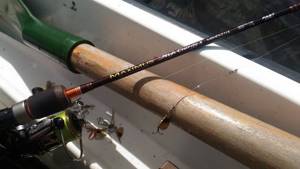
Among the rods produced under the Maximus brand, examples include the High Energy-X 18UL and 21UL, as well as the more “advanced” Egoist-X 602UL or 662UL. They cope well with casting light baits and forgive some mistakes when landing fish. In addition, with their help you can feel the play of the spinner, its contact with underwater obstacles and, of course, bites.
There is no need to be afraid that these spinning rods are too light and “elegant”. They are able to cope with relatively large specimens. For example, my personal record for High Energy-X 21UL is a pike weighing more than 5 kg.
Coil
In our case, the most expensive fishing attribute.
The reel should be light, no heavier than 225-230g (and if less than two hundred, that’s just fine), have an easy move and lay thin cords evenly. Regular monofilament line can of course also be used. But do not forget that such savings will negate the sensitivity of the gear.
The main feature of a spinning reel designed to work with thin cords and fishing lines is a small spool. Just don’t confuse them with reels for match rods. They are generally larger and have a rear friction brake adjuster.
Cord
Since we plan to use light baits and we plan to catch fish weighing less than a kilogram, a cord with a breaking load of about 3 kg will be more than enough. In fact, with some skill, you can safely fight with it even with more respectable (up to 5-7 kg) specimens. The main thing is not to tighten it too tightly and set the reel friction brake correctly. Those. When a force close to the breaking load of the cord is applied, the reel should begin to release it, thereby preventing breakage.
As an example, I can cite the inexpensive and reliable six-core Power Phantom Ultralight 0.04 cord. It is quite strong - its breaking load is 2.8 kg, has a good reach and goes well with light baits.
Techniques and tactics for fishing with a spinner for perch
To catch perch at depth with a spinner spoon, Long or Comet-shaped petals are often used. After casting, the spoon should sink to the bottom and only then is it slowly brought to the speed of opening the petal. If there are no bites, the speed of the bait should be gradually increased. At a depth of three meters or more, it is advisable to catch perch with spinners with a larger load.
When fishing the surface layer and overgrown areas, small spinners without shipping with Aglia or Comet petals are used. Wiring becomes “easier” and faster. By the way, in the grass it is difficult to count on trophy specimens, so here it is appropriate to use bait no higher than number three.
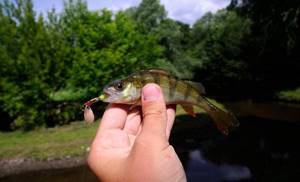
If after several dozen casts there is not a single bite, perhaps the flock is located away from the casting site. In this case, it is necessary to use area fishing tactics:
- "Fan" casts. The wiring pattern will look like rays emanating from one point.
- "Net". The spinner, moving along the shore, fishes areas of water at an angle of 45 degrees to his right and left. The wiring pattern is similar to a fishing net.
It often happens that the activity of perch can change dramatically on different days. There are many reasons: overfeeding of the predator, a pressure shift, a drop in water temperature during the day, the school moving to another place, etc. We recommend having spoons of different sizes . The smaller the spinner, the greater the chance of a catch. If there are enough fish in the reservoir, the likelihood of catching a trophy striper increases. To cut off small predators, we recommend increasing the size of the bait.
On active fishing days, perch bites often alternate with pike attacks. This is true when using large turntables. In order not to lose an expensive lure, we recommend installing metal leashes.
On narrow rivers, ditches or casting bait along the shore, experienced spinners recommend starting with short runs along the shore at an acute angle.
Perch habitats
You can get a significant catch of perch while fishing with a spoon if you know its habitat. Its presence in water bodies is affected by weather conditions and time of year. For example, in early spring, spawning striper prefers passive baits (silicone larvae, worms, slugs), but can also peck on a spinner. In the spring, it is necessary to catch perch near the bottom, using slow retrieval.
In the first warm days after the water warms up, the freshwater predator readily grabs any spinning and oscillating spoons. The fish quickly grabs the bait and chases it during the retrieve. In summer, perch hunts in the upper layers of the reservoir or hides near the coastal grass. Riffles can also be excellent places for fishing.
The first cold weather forces the striped fish to go to the bottom. This time is ideal for using weighted rotators and micro-oscillators. They help to quickly catch the bottom layer of water, where schools of perch are localized.
Selecting a location
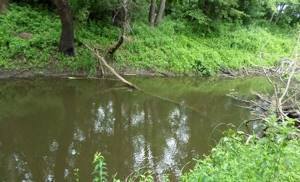
Catching perch with a spinner spoon in open water is characterized by searching for traditional places where the predator gathers at depth. Usually it stands on dumps near river beds or near bottom holes. As a rule, you can also catch another large predator there, for example, pike perch or asp.
In shallow water or in small lakes, small and medium-sized perch often bite. Just like the medium-sized pike, the striped one likes to set up ambushes in thickets, snags, or near artificial “reefs” made from human waste (sunken tires, concrete blocks, etc.).
If the place is unfamiliar to you, before casting an expensive spinner, we advise you to conduct reconnaissance with used baits or cheap jig heads. This way you can quickly find safe areas.
A sign that indicates the presence of a perch is the activity of fry jumping out of the reservoir in schools. If the surface is quiet, shallow water along reeds or grass thickets is first fished. Passages in the reeds or “windows” of open water in dense thickets may be promising. In these places there is no need for long casts - the predator can stand almost underfoot.
Wiring
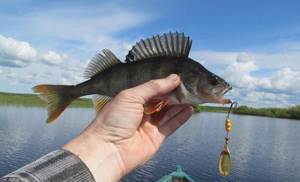
After casting the bait, it is necessary to determine the optimal speed of its movement in the water. When the petal starts playing, the spinner is moved without sudden jerks. The speed of twist of the coil should allow the petal to fully fulfill its purpose - to create vibrations and attract a predator.
It is best to hold the rod at a slight angle to the surface of the reservoir. This eliminates accidental jerks with the tip of the blank, and in the event of a sharp bite from a large predator, the possibility of damage to the rod.
The best wiring option is to move the bait on the verge of falling. At this speed, even the most lethargic predator should be tempted to attack. If there are no bites, you need to increase the speed; perhaps the perch for some reason does not react to the slow bait.
Long type turntable wiring
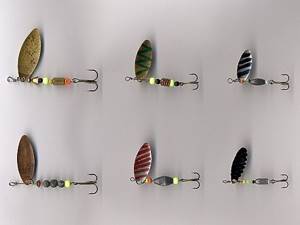
Photo by the author
“The speed of wiring should always be the minimum possible, on the verge of breaking the petal” - M. Balachevtsev, “Features of wiring” (Fishing in Russia No. 1/2004). The idea, so succinctly and beautifully formulated by M. Balachevtsev, is by no means new. In one form or another, it is present in almost any serious work on spinning. In general, I agree with her. But still…
I remember every fishing trip in the first year of mastering spinning as if it were now, although many years have passed. I was theoretically savvy and tried to move the baits deep and slowly. There were problems with technology. And then, on Lake Dolgoy near Shatura, on the fifth or sixth cast, the “spinner” plopped into the water about ten meters from the side of the boat. Taking a deep breath, I began to reel in the line at maximum speed. And... I pulled out the first perch. Accident? No. Super-fast retrieving is a magical technique; I caught a significant part of my fish thanks to it.
With all due respect to the luminaries of spinning, including Maxim Balachevtsev personally, I have to say: everything is not so simple. There are so many nuances in the wiring of the “turntable” that I cannot decide to describe them in general terms. I will limit myself to describing the wiring of the “willow leaf”, which I use more often than other spinners.
Wiring direction
This section will focus on horizontal direction projection. The vertical will be discussed in the section “Depth and speed of wiring”. Changing the direction of wiring is desirable in all cases where it is possible. This is such a powerful technique that when fishing from a boat drifting downwind, you often don’t need anything else: you cast across the wind, reel in evenly, and a bite follows in the zone of “maximum curvature.” What if there is no wind? However, let's take it in order.
1. No current, no wind
Or the current and wind are weak. Of course, there is no exact limit, but from the point of view of wiring the “turntable”, you can ignore the wind up to about 1 m/s and the current up to 0.2 m/s.
Regardless of the presence of a boat, there is no possibility to change the direction of the passage (we do not consider the exotic possibility of having a boat with a rower). Not often, but there are spinning players who, when reeling, more or less smoothly throw the spinning rod from the far right to the far left position and back. Sometimes there is a positive effect from this technique, but not due to a change in direction, but due to a change in the speed of the drive. The direction in this way can be changed to any noticeable extent only at a short distance and at a shallow depth of fishing, when there is little fishing line in the water. However, there is an interesting special case. Even a small change in direction is sometimes enough to circle an obstacle (a snag, a stone, an island of grass) or, on the contrary, to bring the bait closer to it. This is very effective and quite achievable by manipulating the spinning rod (the longer it is, the better in this sense). 2. There is no current, there is wind
To make full use of the wind, you need to fish from a drifting boat. The optimal drift speed depends on many factors (in particular, the depth of the drive). With my fishing style, it ranges from 1.5 to 2.5 km/h. – I’m only talking about wiring, I don’t take all other considerations into account here. If the drift speed is insufficient, it is better to fish while standing. You could probably set up a sail, but I haven't tried it and haven't heard of anyone trying it. If the drift speed is high (this is usually the case), you need to fish while sitting; in stronger winds, use a sea anchor. The simplest option is a plastic bucket tied by the handle to a 5-meter rope. You can buy or make your own more complex, adjustable anchor (a bag with a rim in the neck and a tightening hole in the bottom). Its design is described in detail, for example, in the article by W. Bayer “Three stages of catching a large predator” in “Fish with us” No. 1/1999.
It is best to cast in such a way that at the moment the casting begins (when the bait reaches the required depth), the conventional straight line “fisherman - bait” is perpendicular to the direction of the wind. In most cases, it is better to cast “low”, at a slight angle to the horizon, and slow down the descent of the line in the final casting phase. This allows you to reduce the drift of the fishing line by the wind and achieve maximum curvature of the wiring trajectory.
When fishing from the shore or from a stationary (anchored) boat, the wind is often an enemy rather than an ally. But sometimes a side wind can be turned into an ally. To do this, use a thick line and cast with a “canopy”, allowing the wind to blow out a large loop of line. There is no braking; on the contrary, you can close the reel bail (I fish with a spinning reel) not at the moment the bait falls into the water, but after a short pause. Then we lower the tip of the spinning rod into the water, wait until the fishing line falls on the water and gets wet, with a couple of vigorous turns of the reel handle we submerge the fishing line, remove the tip of the spinning rod from the water and perform the retrieval. It would probably be better to leave the tip of the spinning rod immersed in water, but I can’t do it - I can’t feel the wiring, I don’t even understand whether the petal is rotating, the cord is thick.
It is not easy to achieve such a curvature of the bait trajectory using the described method so that it noticeably affects the bite. Therefore, I rarely use this technique in its pure form. But there is an interesting special case here too. If, during a crosswind, the sun shines in the ear or (even better) from the side of the back of the head, this technique allows you to move the spinner from the shadow side of the obstacle, which improves the bite several times. The most convenient obstacles are sparsely located islands of grass. The best of them are reed islands on relatively clean water (with a small amount of soft aquatic vegetation). The fact that the reed protrudes a meter out of the water does not prevent you from throwing the bait behind it and passing it along the border of light and shadow. Much worse is that the water in the area where the line loop should go is rarely clean. As a rule, there are obstacles that prevent you from forming a perfect loop. In this case, you have to look for a compromise between the desired and the actual.
3. There is a current, but there is no wind
To reduce the impact of the current on the retrieve, you need to fish with rafting, but this applies more to jig-spinning on large rivers. For us, “turntable players,” the current is a great help. Firstly, during the current, the fish are forced to react faster, and therefore are less careful. In addition, the current allows you to diversify the presentation of the bait by changing the angle between the current and the direction of the retrieve. And finally, the current is never absolutely smooth; it significantly affects the movement of both our bait and the natural food of the fish, making them similar to each other without any effort on our part. Therefore, we will fish from the shore (from bridges, wading, etc.) or from a stationary boat.
If you cast not strictly upstream or downstream, the bait will definitely change direction when retrieving. This is most clearly manifested when retrieving “for demolition”, when the cast is performed perpendicular to the current, and retrieving (depending on the strength of the current and depth) is carried out with slow reeling of the line or without reeling at all. In strong currents, you can even give up the fishing line when retrieving, but this is a rather complicated technical technique.
In short, during the current the bait itself changes the direction of movement, and the subtleties and nuances of this process are beyond the scope of this article. Although... I would like to describe one interesting special case. On a small river, you can throw the bait into an area without current under the opposite bank (or even onto the bank) and let the current pull a loop of line from the reel. This will allow the bait to be passed downstream under the bank farthest from the angler, which is usually very effective. T. Bochorishvili once taught me this technique. He uses a floating wobbler, but in some cases a spinner is more convenient. The current, unlike the wind, continues to put pressure on the line even after the start of wiring, and the middle of the river is usually free of obstacles, which gives us complete freedom in forming a loop. Therefore, I advise you to use this wonderful technique whenever possible.
4. There is a current, there is wind
As a first approximation, it is advantageous for us to use the current and reduce (by low, sharp casts) the influence of the wind. The exception is the wind blowing along a weak current or against a strong one. Such a wind will expand our fishing capabilities both from a freely drifting and stationary boat (shore). If we study the problem of the simultaneous use of current and wind in more detail, try to describe all possible combinations of their directions and strength, then even a thick book will not be enough. I won't do this. I hope that understanding the basic principles described in the previous two paragraphs will help you, as you gain experience, solve this problem more and more effectively without conscious calculations, at the level of intuition.
Wiring depth and speed
To be honest, I am not ready to answer the question in which water horizon the wiring should be carried out. As a rule, we try to move the spinner near the bottom, and explore the water column only if there is any indication for this, for example, a large number of fry in the upper layers of the water. But there are so many exceptions to this rule... However, even heavy spinners on a thin line go no deeper than three, maximum four meters. Therefore, most often we have to solve the problem of maximizing the depth of the turntable. The main tool for this is step wiring. Since, unlike jig-spinning, the free-fall phase of the bait almost does not produce bites, it is advisable to perform it as rarely as possible. Contact with the bottom is desirable for precise control of the retrieve, but it can be avoided if you have good knowledge of the fishing area, a cluttered bottom, insufficient strength of the gear, or high value of the bait.
If there is no need to deepen the turntable as much as possible, wavy wiring can be used. To create a smooth “wave” you can raise and lower the tip of the spinning rod, but I prefer to change the speed of rotation of the reel. A variant of the wave-like one can be considered an uneven drive, in which accelerations and decelerations do not alternate regularly - for example, one or two accelerations against the background of a uniform drive, which is still the main one, especially in the current.
In contrast to the clearly useful change in the direction of wiring, changing the speed (and, accordingly, depth) is not so simple. I have a hypothesis on this matter: the less predatory fish we catch, the more uniform the wiring should be. That is, when fishing for pike, accelerating and decelerating movements are usually useful, while when fishing for ide, they are usually harmful (please remember that we are talking exclusively about “long” type spinners; I can’t judge how true this is for other types of lures). So far, the hypothesis has been confirmed by practice, but the experience of one person, of course, is not enough.
Let's return to the epigraph. I don’t argue, in most cases the spinning should be done slowly. But this limits us, firstly, in choosing the wiring depth, and secondly, and no less important, in choosing the rotation speed of the petal. I don’t know what exactly affects the predator – speed or this very frequency, which increases with increasing speed; but very often a bite during a fast retrieve occurs where before there were no bites on several slow retrieves. And it happens (although not often) that 90% of bites occur with ultra-fast wiring. In a word, from time to time it is necessary to “check” the fast retrieve; I do this approximately every 10 casts.
Separately, it is necessary to say about the wiring up the slope, from the depths to the shallows. This technique is complex, but very effective. With uniform wiring, the spinner should go in close proximity to the bottom. The problem is to choose the necessary bait, fishing line, retrieve speed, distance of the boat to the top edge, and casting angle to the edge. If everything is done correctly, you can fish to significant depths and achieve such results that jig fishing masters will be jealous.
Petal torn off
Let's return to the epigraph once again. “Slowly” and “on the verge of falling off a petal” are by no means synonymous. For different turntables, the minimum possible wiring speed at which the petal begins to “fail” is different. I am convinced that it is the tearing of the petal that attracts the fish, and not the low speed of the retrieve. This is precisely what explains the statements of novice fishermen like: “I didn’t see a bite on the branded spoon, but I hung a Chinese fake - one after another!” The fake petal malfunctioned at medium wiring speed; If the branded turntable had been run more slowly, with glitches, it would have bitten just as bad. Driving the turntable at low speed is a simple and natural way to cause the petal to fail. But by no means the best. Firstly, the lower the speed of the retrieve, the lower the rate of searching for fish. Secondly, the turntable carried out on the verge of failure of the petal is susceptible to snags. The petal does not have enough energy to “repel” the spinner from the obstacle.
To cause the petal to fail at an average fishing speed, you can periodically shake the spinning rod sharply or use obstacles. I don’t want to say anything bad about “shaking,” but this technique didn’t catch on with me—it didn’t suit my character. I go fishing on vacation. Therefore, I use obstacles, primarily the bottom and only in desperate situations - aquatic vegetation. It is easier to use the bottom, firstly, because it is everywhere, and secondly, because the spinner bounces upward from it - to where there are no obstacles. Aquatic vegetation is oriented mainly vertically, the spinner is knocked off to the side. If there is another obstacle there, the pinwheel will get caught on it. Therefore, when the petal hits an obstacle, the turntable must deviate to the side so as not to get caught on it by the tee - no less, but no more. The best way to solve this problem is a “long”, carried out at an average pace (however, the optimal wiring speed for each “long” is different).
So why do experts advise performing the turntable slowly? Well, firstly, it is really effective, especially when the fish are highly active, reacting to the spinner from a long distance and ready to chase it. Secondly, for several decades now the development of spinning has been following the path of using ever smaller baits and thin, delicate gear. This allows you to catch cautious fish and increases the pleasure of fishing, but aggravates the problem of achieving the required depth, therefore, forcing you to slow down the retrieve. Thirdly, universal baits (namely, they are what masters focus on when teaching beginners) do not allow you to perform the wiring techniques described above in all conditions. There is nothing easier than making with your own hands the kind of “long” that is needed in a particular situation - lightweight, weighted, with an increased or decreased angle of spread of the petal. Do it and catch it!
Andrey Koltsov October 10, 2014 at 01:25 pm
